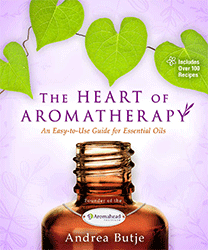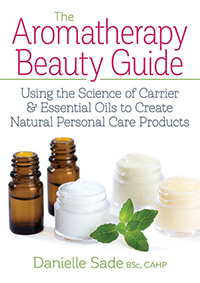Aromatherapy Reed Diffuser Recipe Using Essential Oils

Reed diffusers have been gaining a lot of attention over the past few years because they are attractive, unique and versatile. There are hundreds of reed diffuser fragrances available, and you can use your own bottles/vases or purchase ones especially made to look nice with the reeds.
A reed diffuser is comprised of a bottle or vase filled partially with a highly aromatic oil and several natural rattan reeds. The oil "wicks" up the reeds causing the exposed ends of the reeds to dissipate the aroma into the air. See the picture to the right for an example of a reed diffuser.
It's easy to select your own bottle and make your own aromatic oil, and the recipes on this page will show you how.
I've been hesitant to post a reed diffuser recipe because the diffuser bases that I've seen/heard of are not all-natural. I'm not a fan of recipes that include synthetic ingredients as I don't like the thought of inhaling synthetic or toxic ingredients. I have been getting a lot of emails from visitors that would like to learn how to make their own reed diffuser oil using essential oils, so I've decided to provide a couple recipe ideas for those that are eager to try to make their own reed diffusers.
Although I have dabbled with reed diffusion, I don't consider myself an expert with it. I recommend that you use these recipes as a starting point. As with most recipes that you find in books and online, do plan to experiment and see what works best for you.
Reed Diffuser Recipe #1:
Ingredients and Items Needed
- 6 parts Diffuser Base Oil or 6 parts Dipropylene Glycol
- 4 parts Essential Oil or Essential Oil Blend
- Several Rattan Reeds
The number of rattan reeds that you use will be based on your personal preference and the size of the bottle or vase that you use. - Bottle or Small Vase
Choose a small bottle or vase (one that holds several ounces is best). A clear or pale colored bottle with a mouth that can hold several rattan reeds is best.
Optional Ingredients
- 1-2 parts High Proof Vodka (or Everclear) or Perfumer's Alcohol
Alcohol may be needed if you are working with thicker essential oils or CO22.
Diffuser Oil Base vs. Dipropylene Glycol
There are a number of diffuser oil bases available. If possible, check the ingredients and research them to ensure that you're comfortable using it.
Directions
- Combine the proper portions of your diffuser base oil or dipropylene glycol with your essential oil or essential oil blend and mix well. I find that combining either in a bowl with spout or in a separate bottle works well.
- Essential oils vary in strength as does the effectiveness of particular diffuser base oils, so you may find that you need to adjust the ratios a bit. If you are using stronger essential oils like geranium or peppermint, you'll probably want to use less essential oil.
- If you are using thicker or more gently aromatic essential oils like patchouli, you may find that you need to increase the amount of essential oil used.
- Use alcohol, as described under "Optional Ingredients" if you find that the thicker essential oils aren't wicking up the rod well.
- Experimentation will be needed. Keep a notebook of the exact ingredients, essential oils and proportions that you used so that you can reduplicate your recipe the next time, or adjust it, if needed.
- Pour your aromatic diffuser reed oil into your chosen diffuser bottle.
- Add the rattan reeds to the bottle so that the ends are submerged fully in the oil. Rattan reeds can be cut if needed.
- Every few hours (more or less) over the first day, flip the reeds and place the opposite reed ends back into the bottle. This helps the wicking process. After the first day, flip the reeds every few days.
- Keep the diffuser reeds away from children, pets and anything that could ignite them as the ingredients are flammable.
Reed Diffuser Recipe #2:
All Natural, But Less Effective Version
Ingredients and Items Needed
- 1 part Jojoba, Watermelon Seed Oil or Other Carrier
- 1 part Essential Oil or Essential Oil Blend
- Several Rattan Reeds
The number of rattan reeds that you use will be based on your personal preference and the size of the bottle or vase that you use. - Bottle or Small Vase
Choose a small bottle or vase (one that holds several ounces is best). A clear or pale colored bottle with a mouth that can hold several rattan reeds is best. I recommend using a bottle with a wider mouth than if you were making Reed Diffuser Recipe #1. The wider mouth will help to passively diffuse the blend as this more natural recipe does not wick up the reeds as easily as does recipe #1.
Directions
- Combine equal portions of your chosen carrier oil and essential oil or essential oil blend and mix well. I find that combining either in a bowl with spout or in a separate bottle works well.
- Essential oils vary in strength, so you may find that you need to adjust the ratios a bit. If you are using stronger essential oils like geranium or peppermint, you'll probably want to use less essential oil.
- If you are using thicker or more gently aromatic essential oils like patchouli, you may find that you need to increase the amount of essential oil used.
- Experimentation will be needed. Keep a notebook of the exact ingredients, essential oils and proportions that you used so that you can reduplicate your recipe the next time, or adjust it, if needed.
- Pour your aromatic diffuser reed oil into your chosen diffuser bottle.
- Add the rattan reeds to the bottle so that the ends are submerged fully in the oil. Rattan reeds can be cut if needed.
- Every few hours (more or less) over the first day, flip the reeds and place the opposite reed ends back into the bottle. This helps the wicking process. After the first day, flip the reeds every few days.
- Keep the diffuser reeds away from children, pets and anything that could ignite them as the ingredients are flammable.
Essential Oil Reed Diffuser Blends
AromaWeb's Aromatherapy Diffuser Recipes page contains 17 blends that can be used as a basis for possible diffuser reed blends.
Or, you may prefer to use one of the recipes shown on these pages and adapt it for use in a reed diffuser:
- Anger Reducing Blends
- Anxiety Relieving Blends
- Celebrating and Expressing Gratitude
- Confidence Enhancing Blends
- Calming/Relaxing Blend
- Depression Reducing Blends
- Energizing Blends
- Fear Fighting Blends
- Grief Easing Blends
- Happiness and Peace Enhancing Blends
- Insomnia/Sleeplessness Blend
- Irritability Reducing Blends
- Loneliness Easing Blends
- Memory and Concentration Blends
- Panic and Panic Attack Blends
- Self Confidence/Insecurity Blends
- Stress Reducing Blends
- Winter Blues Blends
- Bay Rum Diffuser Recipe
- Christmas Tree Diffuser Blend
- Sugar & Spice Blend
- Frankincense & Fir Blend
- Frankincense & Myrrh Holiday Blend
General Safety Information
These recipes are offered for educational purposes only. Before using any essential oil, carefully read AromaWeb's Essential Oil Safety Information page. For in-depth information on oil safety issues, read Essential Oil Safety by Robert Tisserand and Rodney Young. Do not take any oils internally and do not apply undiluted essential oils, absolutes, CO2s or other concentrated essences onto the skin without advanced essential oil knowledge or consultation from a qualified aromatherapy practitioner. For general dilution information, read AromaWeb's Guide to Diluting Essential Oils. If you are pregnant, epileptic, have liver damage, have cancer, or have any other medical problem, use oils only under the proper guidance of a qualified aromatherapy practitioner. Use extreme caution when using oils with children and consult a qualified aromatherapy practitioner before using oils with children, the elderly, if you have medical issues or are taking medications.
Do You Need the Ingredients Listed in This Recipe?
You can find the essential oils, other ingredients and packaging that you need by patronizing the fine companies that support AromaWeb with their banner advertising located throughout AromaWeb (See them all at a glance within the Advertiser Spotlight area) and the listings located within the Aromatherapy Business Directory. Many of AromaWeb's advertisers also expertly formulate their own ready-made products if you decide you'd rather not make aromatherapy products yourself.
Do You Want More Essential Oil Recipes and Blends?

Over 800 Recipes!
The Complete Book Of Essential Oils & Aromatherapy
Author: Valerie Ann Worwood

Over 100 Recipes!
The Heart of Aromatherapy
Author: Andrea Butje

100 Recipes!
The Aromatherapy Beauty Guide
Using the Science of Carrier & Essential Oils to Create Natural Personal Care Products
Author: Danielle Sade, BSc, CAHP
Visit AromaWeb's Books area to find details about many other essential oil and aromatherapy books.